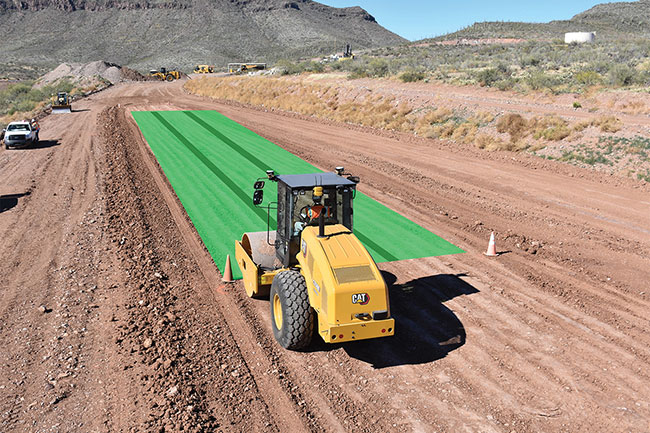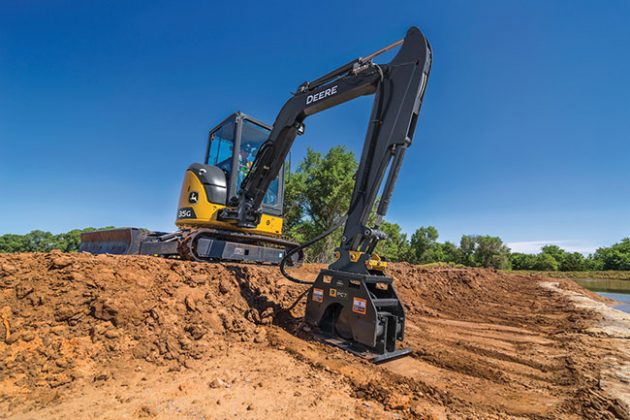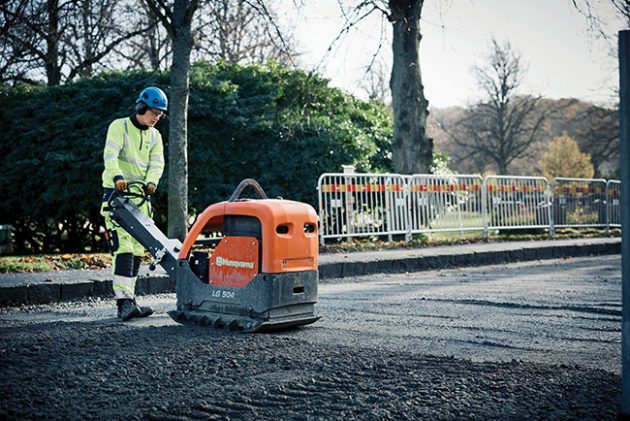
Gaining traction with compaction
By Andrew Snook
Features Tech tips canada compaction rentalAchieving desired results with compaction equipment.
 To offer the correct roller size to customers, it is important to have ample knowledge about the customer’s project. Photo: CAT
To offer the correct roller size to customers, it is important to have ample knowledge about the customer’s project. Photo: CAT When it comes to compaction, some applications are more challenging than others. So, when a customer calls a rental house looking for compaction equipment for a project, compaction product experts strongly advise obtaining as much information about a customer’s project as possible before renting out a machine.
John Deere’s Dan Sant Anselmo, a field service engineer, goes one step further. He says before a machine leaves the rental house, an employee should go through the basic operation of how the machine works with the customer. This should be the case even for an experienced operator, who may not be familiar with a newer technology or feature on the latest equipment.
“We see a lot of issues with general operation of the machines,” Sant Anselmo says. “We have Tier 4 Final machines here now in North America, so I would hammer home the importance of regeneration, and how to perform the proper procedure for the regen system of the exhaust system. They don’t always understand the regen process. They get out to a machine that is running and a regen light pops up and they don’t know the proper procedure. So they either cancel out the regen or ignore it and it downs the machine. We see a lot of that going on. If we could get more education between the rental houses to the end users, you’d see a big decline in having to send technicians out to travel a few hours just to plug into a machine and run a regen.”
Soil compaction
When it comes to the compaction of soil, it’s important that rental houses find out as much as they can about a client’s project, so the correct rollers are rented for the job.
“We see a lot of guys who will just rent a machine and not know the weight of the machine and so they’re either too light for their job or too heavy. Getting the right-sized roller for the job is important, whether they’re looking for a padfoot drum to dry out more material, if you’ve got a wetter material, or a smooth drum for your final compaction.”
It’s also important to know if the customer is using a VIO-drum, Sant Anselmo notes.
“At Hamm [a John Deere company], we offer a vibration and oscillation drum. If we have a high moisture content in the material, we don’t want to use vibration to pump the water up to the top, so we can use the oscillation side of that drum and massage the material back and forth and not pump that water,” he says. “We can also use oscillation where we have vibration restrictions or anywhere we’re doing underground water lines, or gas lines or fiber-optic lines, where we don’t want to vibrate on top of that.”
Sometimes an articulated roller is the right choice for an application.
“With our articulation joints, it turns and gives us an x, y and z access for turning the machine, giving it more stability on the back end for turning and getting more concentrated compaction on the drum because it has a more even distribution of the drum staying in contact with the ground.”
Speed is another important factor for proper soil compaction.
“It’s very important for operators to watch their speeds. You go to a jobsite and you see guys running the machines and vibrating at 4.5 miles an hour. Their impact spacing is so far apart that they’re not getting good compaction, they’re loosening up the material,” he says.
Moisture content on the soil side is also a crucial factor.
“If it’s too dry, depending on the material, the material isn’t going to stick together and bond together. If it’s too wet, then the particles are going to float. So, having the right moisture content is critical,” Sant Anselmo says.
Dave Gerding, global sales consultant for soil compactors at Caterpillar Paving Products, says that his company designs their machines to be as easy to operate as possible. He says this is especially important for soil compactor operators, considering a soil compactor is often the first machine customers put a new operator in.
“It’s got to be easy for them to get in there and operate,” he says. “The more functions that can be automated the better.”
Intelligent construction technologies are extremely helpful for new operators on a job site.
Caterpillar recently launched its Cat Command for Compaction, which is an operator-assisted, semi-autonomous technology that automates the compaction process based on operator inputs. This technology controls the speed, direction, steering, and vibration system of the soil compactor to promote consistency in compaction.
“Command controls the number of passes and coverage,” Gerding says. “This type of process control allows you to get that consistency and good overlap, all while monitoring the compaction level.”

Speed and soil moisture content are important factors to consider when selecting soil compaction equipment. Photo: john deere
Excavator attachments
When it comes to using excavators for soil compaction, they typically use a hydraulic plate compactor or a compaction wheel. Equipping these machines with quick couplers for switching between attachments is recommended.
Justin Steger, product marketing manager for site development and underground for John Deere, says that this addition will help rental houses increase their customers’ jobsite efficiencies for when they need to switch between their buckets for applications like trenching for laying pipe down on the ground, bedding that pipe and backfilling, and then over to compacting the ground.
“It just makes it easier, more efficient. It saves a lot of time throughout the day,” he says, who adds that John Deere machines come with hydraulic quick disconnect systems.
Steger also recommends placing a hydraulic plate compactor on the ground before you operate the hydraulics.
“That will increase the life of your attachments,” Steger says.
Asphalt compaction
Having the right roller for the job, is equally important for the compaction of asphalt, but that doesn’t mean the customer always knows to choose the right equipment. This is where an experienced rental house employee can pay dividends for their customer.
“You need to match the material to the machine to achieve the compaction they’re looking for. Whether it’s a vibration drum or oscillation drum, or a rubber tire roller, what we’re ultimately doing is trying to hit target compaction in the least amount of passes,” Sant Anselmo says.
One of the most important but least known aspects of efficient asphalt compaction is impact spacing.
“A good impact spacing is 12 to 16 impacts per foot. Anything less than 10, you started washboarding out the road,” Sant Anselmo says.
Quite often, impact spacing issues stem from operators moving too quickly.
“The hardest thing I’ve ever had to do is get an operator to slow down,” Sant Anselmo says. “If we slow the machine down and get between that 12 to 16 number of impacts, then we can do less passes, and they can move up to the paver faster.”
He adds that consistency is key to the successful compaction of asphalt.
“Everything we do on right-hand side, we need to do on the left-hand side,” Sant Anselmo says. “Our asphalt temperature also needs to stay consistent.”
Two of the most neglected systems on an asphalt compactor are the water system and the scrapers.
“With the water system, use enough to keep the drum cool and lubricated but not so much that it’s cooling down the material,” Sant Anselmo says. “The scrapers themselves, a lot of guys don’t know what they’re for – they’re dropping water across the drum to give it an even water surface. If the scrapers aren’t in good working order, you get dry spots and you start to pick up the asphalt. I tell guys when they’re not on asphalt to take the scrapers away from the drum, otherwise your wear them out prematurely.”
When it comes to asphalt compaction, doing it right the first time can be the difference between your customer staying on budget or not. Having to bring back their milling and paving crews to a project after it’s completed is a huge expense that nobody wants to endure.
“If you don’t do it right the first time, it gets very costly,” Sant Anselmo says.
Brian Nagel, global sales consultant for technology and utility compactors at Caterpillar Paving Products, says that smart technologies and apps are probably the most important ways to bring consistency into the asphalt compaction process for less experienced crews.
“There are tools out there that help educate and assist a crew to be successful,” he says. “Caterpillar has a paving app that features rolling speed, settings, how many pieces of compaction equipment I should have on the job site and more. A very short-term rental customer is probably not using it, but a customer starting up, or with a new crew may use it.”
The Caterpillar Paving Production Calculator App assists asphalt paving professionals to plan paving projects by helping estimate trucking needs, paving speeds, compaction, yield, slope, thickness, and more. It also has the ability to save specifications of individual jobs to keep for later reference and email job summaries from your device. It operates in metric and U.S. measurements.

Operator manuals that come with the equipment can aid in its maintenance.
Photo: Husqvarna
Small compaction equipment
When it comes to smaller equipment, selecting the right tool for the application is still the key for successful compaction.
“Regardless of what you’re compacting, the first thing to do is make sure you’re picking the right machine for the job,” says Darrell Engle, product manager for light compaction for Husqvarna. “You wouldn’t use a rammer on asphalt, same with some stones. With high impact on stone, all you’re doing is crushing the rock, not getting it to compact. Always know what you’re doing and what machine works better for that particular application.”
There are two basic theories when it comes to compaction. You either want a tool that offers high impact and low frequency, like a rammer; or you want a machine that offers low impact and high frequency, like a roller. While a professional contractor will know what they’re looking for when they walk into a rental equipment house, the same may not be true for a do-it-yourselfer.
“The guy coming in that’s a do-it-yourselfer is just going to come in and ask for something, and the person at the counter will often just give him what wants. But the first thing they should be doing is asking them what they are going to be doing. Maybe a small ride-on roller makes more sense than a forward and reversible plate compactor,” Engle says. “If it’s a contractor, they already know what they want. They’ll ask for a specific piece of equipment. They might even ask for a specific brand.”
One of the nice features offered on some smaller compaction equipment for inexperienced operators are compaction indicator lights.
“This helps the person who is not really skilled,” Engle says. “You can over-compact the ground. By doing that, you’ve caused the material to be crushed instead of compacted, then you have to dig that all up and start all over again. With the compaction indicator, every time you make a pass it will offer a light… it eventually tells you to stop compacting.”
The other benefit the indicator light offers is that it allows a contractor to not put a skilled person on that machine.
“As long as they’re paying attention to the light, anyone off the street would be able to compact the ground without destroying it. Just about anyone on a jobsite could run that machine,” Engle says.
When selecting the right piece of compaction equipment for your client, Engle recommends rental stores source equipment with low vibration.
“Always look for machines that are low vibration for the operator. It doesn’t matter who you are, if you’re constantly being exposed to vibrations in your hands, it’s going to wear you out,” he says. “If you’re not in a refreshed state or sluggish and getting tired, your work is not going to be any good. Definitely look for equipment with the operator in mind. Your safety is always as important as the job.”
As much as it might seem a no-brainer, Engle also strongly suggests reviewing the operator manual for any compaction equipment.
“There’s a reason that machines are sent with it. You’ll find tips in there to know how to operate it properly. It will also give you a maintenance guide. If you want good work coming out of the machine, you have to make sure it’s in good working order,” he says.
Vibration reduction
While some smaller compaction equipment can produce significant amounts of vibration, they are not the only tools contributing to the potential negative health effects associated with vibrating equipment on a jobsite.
“Vibration is something that impacts any user that uses any piece of power equipment,” says Kevin Gee, director of product management at Milwaukee Tool.
Absorbing the vibration from power tools over a long period of time can lead to the user developing Raynaud’s disease, also known as white finger disease.
“Over a long, sustained period of time it can be really detrimental,” Gee says, adding that workers often end up losing feeling in their fingertips or end up with an inability to grip and feel things long-term.
To reduce the possibility of power tool users developing Raynaud’s disease, Milwaukee Tool recently released a wide line of anti-vibration tools, including hammers and drill-drivers, to name a few.
Gee says that preventing the disease can potentially generate big savings for companies by reducing employee downtime. He recommends a few tips for tool operators to keep their fingers healthy.
“Reduce your sustained time in that zone,” he says. “Once you feel your fingers start to tingle, it’s time to stop. And keep your hands warm. If your hands are cold, it’s easier to damage them from vibration.”
Gee also says operators should be cognizant of maintaining healthy blood flow.
“Stop gripping onto the tool, when possible, and stretch your fingers out. If you can have a piece of equipment that has lower vibration, it’s what I would recommend,” he says.
Print this page